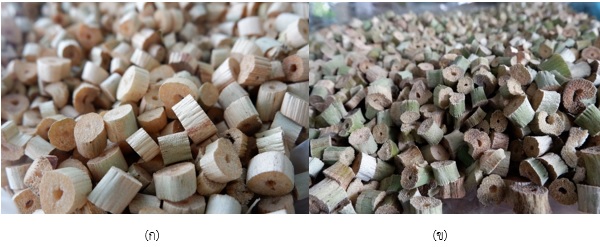
Researcher name: Phatchareephon Niroka, Lect. Dr. Gunn Panprayun, and Lect. Dr. Piangjai Peerakiatkhajohn
Research details: It has been several studied to utilize and reduce amount of water hyacinth due to the problem of rapid growth of water hyacinth. The community enterprise Nara Phirom group network has produced dried water hyacinth as an animal bedding for National Laboratory Animal Center, Mahidol University. However, the natural sun drying provides low quality. The growth of fungus makes the product with black spot owing to it depends on the weather factors. Therefore, this research has designed and constructed a solar greenhouse dryer for drying water hyacinth, to replace the imported bedding materials, make local income, and solve aquatic ecosystem problem. Which using high potential of renewable energy sources, to replace fossil fuels for drying or dehumidifying of product. The solar dryer located in community enterprise Nara Phirom group network, Khlong Yong Sub-district, Phutthamonthon District, Nakhon Pathom, Thailand. It consists of a parabolic roof structure covered with polycarbonate sheets. The solar dryer basement is a high platform of black metal sheet with 2-inch thick foam insulation covering a 20 m2 base area. Three ventilation fans powered by 100-W solar cell modules with a 0.54 kWh battery were installed on the top of the dryer. The fans operated to keep the relative humidity in range of the desired conditions. Two sensors were used to regulate ventilators and installed on both the inside and outside of the dryer. The fans will be operated when the relative humidity in range of the set conditions. The results of this study demonstrated that the present drying system has an overall efficiency of 78% for 100 kg of water hyacinth. After installation the relative humidity control set, the drying time was reduced and the drying rate could be increased by 0.5 times when taking out the dried sample and replace the new sample in that shelf. It provides high drying rate and less drying time than natural sun drying. The solar dryer has minimum drying time is 8 hours, while the natural sun drying is 12 hours. Moreover, the dried water hyacinth product in this dryer showed better quality of color and shape than the natural sun drying. Owing to the efficient environmental factors controlling in the drying process especially the climatic conditions, dust contamination, and insect disturbance.
Publishing work: Niroka, P., Panprayun, G., & Peerakiatkhajohn, P. (2018, June). A Study on Efficiency of Solar Greenhouse Dryer for Drying Water Hyacinth (Eichhornia crassipes). 14th Conference on Energy Network of Thailand: Modern Energy for Smart City, Thailand.
Utilization from research: The knowledge from this research is a useful guideline for design and construction solar greenhouse dryer in the communities. To use for drying water hyacinth or another product, which make a career and income for local in another way. It also promotes the use of renewable energy sources to replace fossil fuels for drying or dehumidifying of product.
Key contact person:
Phatchareephon Niroka, 094 290 6219, E-mail: This email address is being protected from spambots. You need JavaScript enabled to view it. Dr.Gunn Panprayun, 0 2441 5000 ต่อ 2215, E-mail: This email address is being protected from spambots. You need JavaScript enabled to view it.
ชื่อผลงานวิจัย: ประสิทธิภาพโรงอบแห้งพลังงานแสงอาทิตย์แบบเรือนกระจกสำหรับการอบแห้งผักตบชวา (Eichhornia crassipes)
ชื่อผู้วิจัย: นางสาวพัชรีพร นิโรคะ อาจารย์ ดร.กันต์ ปานประยูร และ อาจารย์ ดร.เพียงใจ พีระเกียรติขจร
รายละเอียดผลงานวิจัย (โดยย่อ): จากปัญหาการเจริญเติบโตอย่างรวดเร็วของผักตบชวา จึงได้มีการศึกษาหาแนวทางการนำผักตบชวาไปใช้ประโยชน์ด้านต่าง ๆ เพื่อลดปริมาณของผักตบชวา กลุ่มวิสาหกิจชุมชนกลุ่มเครือข่ายนราภิรมย์จึงได้นำผักตบชวามาผลิตเป็นวัสดุรองนอนของสัตว์ทดลองให้กับศูนย์สัตว์ทดลองแห่งชาติ มหาวิทยาลัยมหิดล ซึ่งใช้ผักตบชวาแห้งเป็นวัตถุดิบหลัก อย่างไรก็ตามพบว่าวิธีที่ใช้ตากแห้งผักตบชวาในปัจจุบันทำให้วัตถุดิบไม่ได้คุณภาพตามต้องการ เนื่องจากขึ้นอยู่กับปัจจัยด้านสภาพอากาศ ดังนั้นในงานวิจัยนี้จึงได้ทำการออกแบบและสร้างโรงอบแห้งพลังงานแสงอาทิตย์แบบเรือนกระจกสำหรับอบแห้งผักตบชวา เพื่อทดแทนการนำเข้าวัสดุ สร้างรายได้ให้แก่คนในท้องถิ่น รวมทั้งแก้ไขปัญหามลพิษทางน้ำที่เกิดขึ้น ซึ่งอาศัยพลังงานความร้อนจากแสงอาทิตย์ นับเป็นการใช้ประโยชน์จากแหล่งพลังงานหมุนเวียนที่สะอาดและมีศักยภาพสูง สามารถทดแทนการใช้พลังงานเชื้อเพลิงฟอสซิลสำหรับอบแห้งหรือลดความชื้น โรงอบแห้งพลังงานแสงอาทิตย์นี้ตั้งอยู่ ณ กลุ่มวิสาหกิจชุมชนเครือข่ายนราภิรมย์ ตำบลคลองโยง อำเภอพุทธมณฑล จังหวัดนครปฐม มีขนาดพื้นที่ 20 ตารางเมตร ประกอบด้วยหลังคาโค้งพาลาโบล่าปิดคลุมด้วยแผ่นโพลีคาร์บอเนต ทั้งนี้โรงอบออกแบบให้ยกพื้นสูงด้วยฉนวนโฟมหนา 2 นิ้ว และประกบกับแผ่นเมทัลชีทสีดำทั้งสองด้าน บริเวณด้านหลังของโรงอบทำการติดตั้งพัดลมระบายอากาศจำนวน 3 ตัว ทำงานด้วยระบบโซล่าเซลล์ขนาด 100 วัตต์ ใช้แบตเตอรี่ขนาด 0.54 กิโลวัตต์-ชั่วโมง สำหรับเก็บพลังงานแสงอาทิตย์ รวมทั้งติดตั้งเซนเซอร์ทั้งภายในและภายนอกโรงอบเพื่อควบคุมการทำงานของพัดลมระบายอากาศ ซึ่งพัดลมจะทำงานเมื่อความชื้นสัมพัทธ์เป็นไปตามเงื่อนไขที่กำหนด ซึ่งจากการศึกษาประสิทธิภาพโรงอบแห้งพลังงานแสงอาทิตย์แบบเรือนกระจกสำหรับการอบแห้งผักตบชวา 100 กิโลกรัม ในงานวิจัยนี้พบว่า มีประสิทธิภาพการอบแห้งสูงถึง 78% จากการติดตั้งชุดควบคุมความชื้นทำให้ระยะเวลาในการอบแห้งลดลงและสามารถเพิ่มอัตราการอบแห้งได้ 0.5 เท่า เมื่อนำผักตบชวาในชั้นที่แห้งออกก่อนและนำตัวอย่างใหม่ใส่แทนที่ในชั้นเดิม มีอัตราการอบแห้งสูงและใช้ระยะเวลาการอบแห้งน้อยกว่าวิธีการตากกลางแจ้งโดยทั่วไป ซึ่งใช้ระยะเวลาการอบแห้งน้อยที่สุดเพียง 8 ชั่วโมง ในขณะที่การตากกลางแจ้งใช้ระยะเวลาถึง 12 ชั่วโมง อีกทั้งผักตบชวาที่อบแห้งภายในโรงอบแห้งพลังงานแสงอาทิตย์แบบเรือนกระจกนี้ให้คุณภาพรูปทรงและสีที่ดีกว่าผักตบชวาที่ตากกลางแจ้ง เนื่องจากการอบแห้งโดยอาศัยโรงอบแห้งพลังงานแสงอาทิตย์นั้นเป็นระบบปิดและสามารถควบคุมปัจจัยสภาวะแวดล้อมที่มีผลต่อการอบแห้ง โดยเฉพาะสภาพอากาศ การปนเปื้อนจากฝุ่นละออง และการรบกวนของแมลง

ลักษณะรูปทรงและสีของผักตบชวาที่อบแห้งในโรงอบ (ก) และผักตบชวาที่ตากกลางแจ้ง (ข)
การเผยแพร่ผลงาน: พัชรีพร นิโรคะ, กันต์ ปานประยูร, และเพียงใจ พีระเกียรติขจร. (2561, มิถุนายน).
การศึกษาประสิทธิภาพโรงอบแห้งพลังงานแสงอาทิตย์แบบเรือนกระจกสำหรับอบแห้งผักตบชวา (Eichhornia crassipes). การประชุมวิชาการเครือข่ายพลังงานแห่งประเทศไทยครั้งที่ 14: พลังงานยุคใหม่สู่การพัฒนาเมืองอัจฉริยะ, ประเทศไทย.
การนำไปใช้ประโยชน์: สามารถนำองค์ความรู้จากงานวิจัยครั้งนี้ไปใช้เป็นแนวทางในการสร้างโรงอบแห้งพลังงานแสงอาทิตย์แบบเรือนกระจกสำหรับชุมชน เพื่อใช้ในการอบแห้งผักตบชวาหรือผลิตภัณฑ์อื่น ๆ ซึ่งเป็นการสร้างอาชีพ สร้างรายได้ให้แก่คนในท้องถิ่นได้อีกทางหนึ่ง รวมทั้งเป็นส่งเสริมการใช้ประโยชน์จากแหล่งพลังงานหมุนเวียนที่สะอาดทดแทนการใช้พลังงานเชื้อเพลิงฟอสซิลสำหรับอบแห้งหรือลดความชื้นอีกด้วย
ผู้ติดต่อ: นางสาวพัชรีพร นิโรคะ, 094 290 6219, E-mail: This email address is being protected from spambots. You need JavaScript enabled to view it.
อาจารย์ ดร.กันต์ ปานประยูร, 0 2441 5000 ต่อ 2215, E-mail: This email address is being protected from spambots. You need JavaScript enabled to view it.
